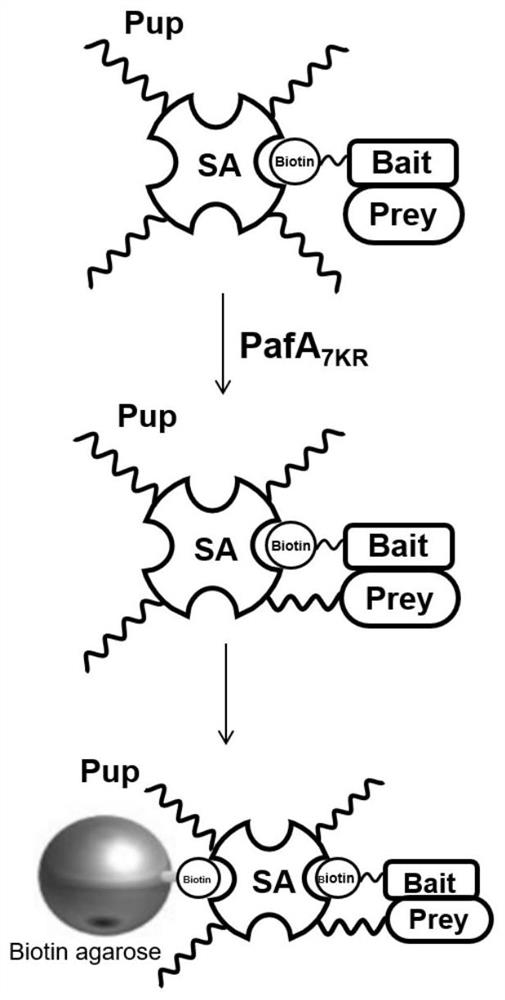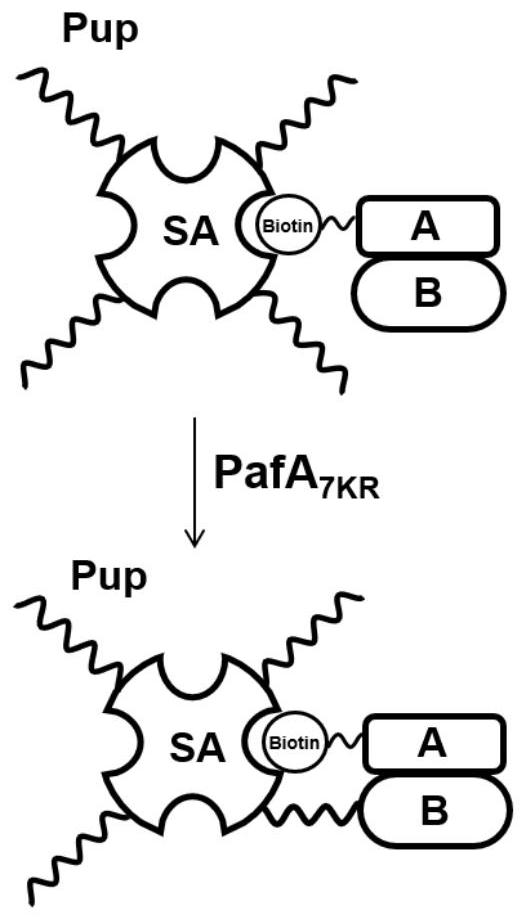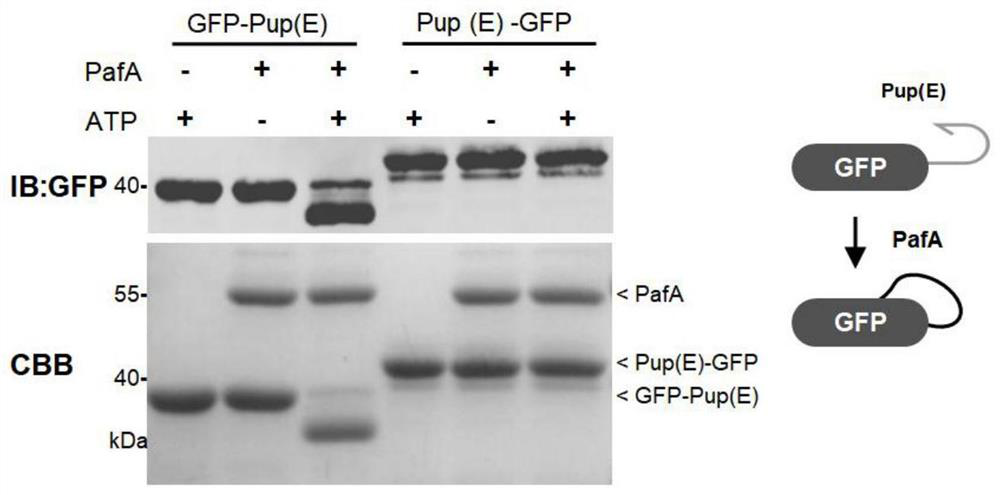Known molecule and protein interaction detection system based on covalent linkage and identification or verification method thereof
A detection system and covalent connection technology, applied in the field of molecular biology, can solve the problems of complex operation and difficult weak interaction detection, and achieve the effect of simple operation, maintaining structure and activity, and accurate detection.
- Summary
- Abstract
- Description
- Claims
- Application Information
AI Technical Summary
Problems solved by technology
Method used
Image
Examples
Embodiment 1
[0086] Example 1: Reactivity verification of PafA and Pup(E)
[0087] 1. Obtain GFP-Pup(E) and Pup(E)-GFP protein
[0088] Pup(E) refers to the mutation of glutamine (Q) at the C-terminus of the wild-type Pup molecule (sequence shown in SEQ NO.1) to glutamic acid (E). Pup(E) was fused and expressed at the N-terminus and C-terminus of the GFP protein respectively, and GFP-Pup(E) and Pup(E)-GFP were respectively constructed on pET28a and transformed into E.coli BL21(DE3) strain, wherein A 6×His tag was attached to the end without Pup(E). Culture 1L bacteria solution, OD 600 When ≈0.6, add IPTG, induce overnight at 18°C, and purify with nickel column to obtain GFP-Pup(E) and Pup(E)-GFP proteins.
[0089] 2. Acquisition of PafA enzyme
[0090] The wild-type PafA sequence is shown in SEQ NO.6. PafA was connected to pTrc99a vector and transformed into E.coliBL21(DE3) strain, wherein the C-terminus of PafA was connected with a 6×His tag. Culture 1L bacteria solution, OD 600 Whe...
Embodiment 2
[0093] Example 2: Transformation and Activity Verification of Streptavidin-Pup
[0094] 1. Obtain the modified streptavidin-Pup tetramer protein
[0095] In order to avoid streptavidin-Pup self-linkage (Pup sequence is shown in SEQ ID NO.1), the lysine on the surface of the streptavidin protein and the Pup molecule is mutated to arginine, and the mutated streptavidin Andin-Pup tetramer (SA m -Pup E ) amino acid sequence (SEQ ID NO.5) such as Figure 4 As shown in a (where Pup E The sequence is shown in SEQ ID NO.2). Will SA m -Pup E Constructed on pET28a vector and transformed into E.coli BL31(DE3) strain. Culture 1L bacteria solution, OD 600 When ≈0.6, add IPTG with a final concentration of 0.5mM, induce for 4 hours at 37°C, and use the inclusion body refolding method (Michael T.Jacobsen et al., 2017.Cell.Chem.Bio., 2017Aug 17; 24(8) :1040-1047) purified to obtain SA m -Pup E protein.
[0096] 2. Detection of SA m -Pup E biotin-binding activity, such as Figure...
Embodiment 3
[0101] Example 3: Transformation and Activity Verification of PafA Enzyme
[0102] 1. Obtain the transformed PafA enzyme, sequence (SEQ ID NO.7) such as Figure 5 as shown in a.
[0103] In order to avoid self-connection of PafA (sequence shown in SEQ ID NO.6), seven lysine sites on its surface were mutated to arginine, and the mutation sites were K162R, K202R, K320R, K361R, K423R, K435R and K446R. use Site-directed mutagenesis kit (Agilent) to construct 7 point-mutated PafA (named PafA 7KR ) was connected to pTrc99a vector and transformed into E.coli BL21(DE3) strain, wherein PafA 7KR A 6×His tag was attached to the C-terminus. Culture 1L bacteria solution, OD 600 When ≈0.6, add IPTG, induce overnight at 18°C, and purify with nickel column to obtain PafA 7KR enzyme.
[0104] 2. Detection of PafA 7KR Enzymes for their own Pupification activity, such as Figure 5 as shown in b.
[0105] will PafA 7KR Enzyme and SA m -Pup E or Pup E Co-incubated at 30°C for 4 ...
PUM
 Login to View More
Login to View More Abstract
Description
Claims
Application Information
 Login to View More
Login to View More - R&D
- Intellectual Property
- Life Sciences
- Materials
- Tech Scout
- Unparalleled Data Quality
- Higher Quality Content
- 60% Fewer Hallucinations
Browse by: Latest US Patents, China's latest patents, Technical Efficacy Thesaurus, Application Domain, Technology Topic, Popular Technical Reports.
© 2025 PatSnap. All rights reserved.Legal|Privacy policy|Modern Slavery Act Transparency Statement|Sitemap|About US| Contact US: help@patsnap.com



